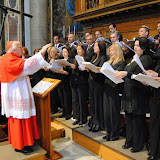Birth. May 7, 1917, Borgo San Lorenzo, archdiocese of Florence, Italy.
Education. When very young, he entered the Archiepiscopal Seminary of Florence, where he was chosen as cantore. In 1939, he obtained the diploma in composition in the Conservatory of Florence. In 1942, in Rome, he obtained the diploma at the Pontifical Institute of Sacred Music; and at Accademia Nazionale di S. Cecilia, after taking the course of perfezionamento in composizione imparted by Ildebrando Pizzetti.
Priesthood. Ordained, December 23, 1939, for the archdiocese of Florence, by Cardinal Elia Dalla Costa, archbishop of Florence. At the death of Maestro Bagnoli, he succeeded him as director of the choir of the cathedral of Florence. In those years he began to compose his first Masses, early motets, organ music, madrigals and chamber music. At the end of 1942, he went to Rome to deepen his knowledge of sacred music. Having served as vice-maestro of the choir of the patriarchal Lateran basilica, in 1947 he became Maestro of the Cappella Musicale Liberiana of the basilica of Santa Maria Maggiore, succeeding Maestro Licinio Refice. In 1952, on the advice of Maestro Lorenzo Perosi, he was appointed vice-maestro of the Sistine Chapel. When Maestro Perosi died in 1956, Pope Pius XII gave him the position of perpetual director of the Cappella Musicale Pontificia "Sistina". Prelate of honor of His Holiness, January 21, 1965. Member of the National Academy of Santa Cecilia. The Cappella Musicale Pontificia Sistina was in poor condition at the death of Maestro Perosi. The situation was improved thanks to the commitment of Maestro Bartolucci and the interest of Pope John XXIII. In 40 years of his leadership he has alternated the papal liturgies with tours in various countries such as Austria, Germany, Ireland, France, Belgium, Holland, Spain, Philippines, Australia, Canada, United States, Turkey, Poland and Japan. In the years of the Second Vatican Council, Maestro Bartolucci, who was against abandoning Latin, was committed to avoid that the liturgical reform would not take a hostile direction toward sacred music. His references in music were the polyphonic tradition of Palestrina and the Gregorian chant. In 1997 he was replaced, in contravention of the papal appointment in perpetuity, as director of the Sistine Chapel, by Msgr. Giuseppe Liberto. This event aroused some controversy in the context of liturgical music; the option was for innovation of the style that best reflected the celebration of the mass preferred by Pope John Paul II; according to many, Bishop Piero Marini, master of papal liturgical celebrations, was responsible for the change. Among those most against the decision was Cardinal Joseph Ratzinger, future Pope Benedict XVI, who recalled Msgr. Bartolucci to direct a concert in the Sistine Chapel, on June 24, 2006, in which the maestro offered music from the repertoire of sacred polyphony of Giovanni Pierluigi da Palestrina alongside his own compositions including the six-voice motet "Oremus pro Pontifice our Benedicto" dedicated to the pope. He has also directed the choir of RAI (Radiotelevisione italiana) and the main Italian complex symphonic-chorals in Rome, Venice, Trieste, Palermo, among others. He is considered the best interpreter of Giovanni Pierluigi da Palestrina. His works have been published in forty nine volumes of Edizioni Cappella Sistina (1).
 |
| Il Cardinale Domenico Bartolucci, già Maestro Direttore della Cappella Musicale Pontificia |
Episcopate. He requested to be dispensed from the requirement of episcopal ordination and the dispensation was granted by Pope Benedict XVI.

Cardinalate. Created cardinal deacon in the consistory of November 20, 2010; received the red biretta and the deaconry of SS. Nomi de Gesù e Maria in via Lata. His cardinalitial motto is Psallam Deo meo. He was older than eighty years at the time of his promotion to the cardinalate and thus not eligible to participate in a conclave.

